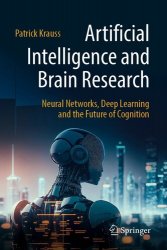Artificial Intelligence and Brain Research: Neural Networks, Deep Learning and the Future of Cognition
- Добавил: literator
- Дата: 13-07-2024, 08:02
- Комментариев: 0
 Название: Artificial Intelligence and Brain Research: Neural Networks, Deep Learning and the Future of Cognition
Название: Artificial Intelligence and Brain Research: Neural Networks, Deep Learning and the Future of CognitionАвтор: Patrick Krauss
Издательство: Springer
Год: 2024
Страниц: 258
Язык: английский
Формат: pdf (true), epub
Размер: 15.3 MB
How does Artificial Intelligence (AI) work and are there parallels to the human brain? What do natural and artificial intelligence have in common, and what are the differences? Is the brain nothing more than a biological computer? What are neural networks and how can the term deep learning be explained simply?
Since the cognitive revolution in the middle of the last century, AI and brain research have been closely intertwined. There have been several spectacular breakthroughs in the field of AI in recent years, from alphaGo to DALL-E 2 and ChatGPT, which were completely unthinkable until recently. However, researchers are already working on the innovations of tomorrow, such as hybrid machine learning or neuro-symbolic AI. But what does this actually mean?
Based on current research findings and exciting practical examples, this non-fiction book provides an understandable introduction to the basics and challenges of these fascinating disciplines. You will learn what neuroscience and psychology know about how the brain works and how artificial intelligence works. You will also learn how AI has revolutionized our understanding of the brain and how findings from brain research are used in computer science to further develop AI algorithms. Discover the fascinating world of these two disciplines. Find out why Artificial Intelligence and brain research are two sides of the same coin and how they will shape our future.
Recently, Artificial Intelligence (AI) and Machine Learning have been making their way into more and more areas, such as medicine, science, education, finance, engineering, entertainment, and even art and music, and are becoming ubiquitous in twenty-first-century life. Particularly in the field of so-called Deep Learning, the progress is extraordinary in every respect, and deep artificial neural networks show impressive performance in a variety of applications such as processing, recognition, and generation of images or natural language. Especially in combination with a method called Reinforcement Learning, the networks are becoming increasingly powerful, for example when it comes to playing video games, or they even achieve superhuman abilities in complex board games like Go, when they are trained by playing millions of games against themselves.
Many of the algorithms, design principles, and concepts used in AI today, such as neural networks or the aforementioned reinforcement learning, have their origins in biology and psychology. Therefore, neuroscience lectures are becoming an integral part of courses such as Computer Science or Artificial Intelligence at more and more universities. But it is also worthwhile for brain researchers to engage with Artificial Intelligence, as it not only provides important tools for data evaluation, but also serves as a model for natural intelligence and has the potential to revolutionize our understanding of the brain.
Deep Learning is a branch of Machine Learning that focuses on artificial neural networks with multiple layers of interconnected neurons. The more layers a neural network has, the “deeper” it is. Modern architectures can have hundreds of layers and are capable of processing and learning from large amounts of data by recognizing complex patterns and establishing abstract connections. One of the greatest achievements of Deep Learning is the ability to train neural networks to process large amounts of unstructured data, such as images or voice recordings, and recognize complex correlations and patterns. This has led to breakthroughs in many application areas, including language processing, image recognition and segmentation, and has enabled advances in medical research, natural sciences, and other fields. The main advantage of Deep Learning is the ability to recognize and learn meaningful patterns in complex and unstructured data without the need for human expertise. Deep Learning models can even work with data that is difficult or impossible for the human mind to interpret, such as digital X-rays. This makes Deep Learning an enormously powerful tool in many fields.
Скачать Artificial Intelligence and Brain Research: Neural Networks, Deep Learning and the Future of Cognition
Внимание
Уважаемый посетитель, Вы зашли на сайт как незарегистрированный пользователь.
Мы рекомендуем Вам зарегистрироваться либо войти на сайт под своим именем.
Уважаемый посетитель, Вы зашли на сайт как незарегистрированный пользователь.
Мы рекомендуем Вам зарегистрироваться либо войти на сайт под своим именем.
Информация
Посетители, находящиеся в группе Гости, не могут оставлять комментарии к данной публикации.
Посетители, находящиеся в группе Гости, не могут оставлять комментарии к данной публикации.
